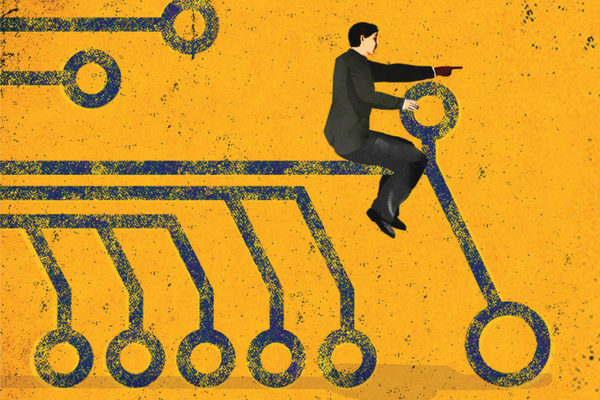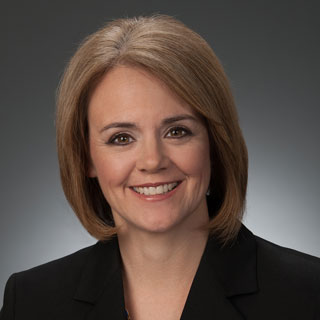CIOs Move to Center Stage

Today, IT is essential to the success of practically every organization — and so is the CIO.
If the business world were a Broadway show, this would be the moment for the chief information officer (CIO) to step into the spotlight.
Data today plays a crucial role in just about every kind of business or government enterprise, from social media platforms made completely of ones and zeroes, to companies that sell shampoo or chainsaws but couldn’t make those products, market them, or dream up new ones without sophisticated data capabilities. “There are very few places where what you accomplish with technology isn’t integral to the business strategy and to how customers and stakeholders perceive a company or agency,” says Howard Spira ’85, MBA ’86, senior vice president and CIO of the Export-Import Bank of the United States (EXIM).

As information technology becomes more critical to business success, the CIO is rising to a new level of influence, from supporting player to one of the names at the top of the marquee.
“Leaders are rapidly scaling their digital businesses, making the remainder of this year and 2018 a defining moment for CIOs who don’t want to be left behind,” according to a 2018 report by Gartner, a leading research and advisory company, announcing the results of a survey of more than 3,000 CIOs worldwide. “[T]he CIO role is transitioning from delivery executive to business executive, from controlling cost and engineering processes, to driving revenue and exploiting data.”
IT and the Value Chain
Back in the day, as a delivery executive, the CIO existed mainly to provide technology to accomplish day-to-day tasks. “Ten years ago, it was all about computers and desktops, and what systems you were putting where,” says Charles Conway, MBA ’07, CIO at Shared Health Diagnostic Services in Winnipeg, Manitoba. Executives decided that they needed certain technology and charged the CIO with procuring, installing, and maintaining it.
A government-owned organization, Shared Health provides laboratory services, diagnostic imaging, and technology services for healthcare providers across Manitoba; it also develops the province’s healthcare services strategy.
In many industries, not only did the CIO mostly provide back-office support, but companies regarded the CIO’s office as a cost center, says Hernan Saenz, MBA ’98, visiting senior lecturer of management and organizations at Johnson, and managing partner and head of the global performance improvement practice at Bain & Company. “The metric people were looking at was, ‘What’s my IT spend as a percent of revenue?’” he says. Those companies did not look to the CIO’s team to generate revenue at all.

There were exceptions, of course. In industries such as finance and telecommunications, where data has long been at the core of the product and the customer experience, CIOs have played a strategic role for quite some time.
Today, though, data and information technology are the key to the strategy and operations of any business, Saenz says. “For example, if I’m making engines and I can put sensors in them, the data from those sensors lets me understand how the engines are performing and when I need to do maintenance. That changes everything.”
At Bain & Company, Saenz helps clients in a broad range of industries work toward business transformation, cost management, and operational excellence. “As you can imagine, there’s a huge digital component in today’s world across a number of dimensions,” he says. “IT is now a critical part of the value chain — how we make things. It is part of the product or service. And it is part of the customer journey.”
So while keeping things running is still an important part of the CIO’s job, a person holding that title now spends much more time helping the organization thrive and grow. “More and more, the CIO is participating in broader strategic discussions and expected to be a value-added contributor about customers, markets, channels, and products,” Spira says.
If you want concrete proof of that evolution, look at a company’s IT budget. In the past, an IT department spent maybe 80 percent of its money on running the business and 20 percent on efforts to expand the business, Saenz says. “That is probably going to change to 50-50, or even more, in a world where running the business — the plumbing — becomes far less important, and growing or powering the business is the true value you provide.”
New Spheres of Influence
For further evidence of this fundamental change, consider the kinds of activities where CIOs now play key roles. Take marketing.
Customer loyalty programs are extremely important in the hospitality industry, says Oh Wacharasin, MBA ’14, who advises CIOs in her role as a senior associate at KPMG. These days, when a customer chooses a hotel, the perks that come with loyalty points may influence the purchase decision even more than the prospect of top-notch service or elegant rooms. “You need data to enable the most competitive loyalty programs [such as] customer reservation data or reward data.” she says. “To manage that amount of data and drive technology initiatives, you need a competent IT organization that works as a business partner, led by a strong CIO.”

With help from the CIO, the organization can also use data from the loyalty program to fuel other marketing initiatives, Wacharasin observes. For example, when a company owns a broad portfolio of properties, the customer relationship management team might analyze loyalty data to learn which hotel categories different guests tend to select. “This information helps marketing departments segment customers, properly target customers, and figure out what kinds of promotions would interest them,” she says.
These days, you’ll also find CIOs getting involved in internal operations that rarely called upon their talents in the past. One example is human resources.
“Typically, HR would be the department leading on how we transform our HR organization to ensure that we have the right people in the right chairs with the right skills at the right time,” says Kristie Grinnell, MBA ’99, CIO and chief supply chain officer at General Dynamics Information Technology (GDIT), a systems integrator and IT services company in Fairfax, Va.
But it was Grinnell’s team that launched Recruit to Retire, an initiative to better attract and retain talent in a highly competitive market. The IT department led this project in partnership with HR.
Grinnell got involved in Recruit to Retire because, as CIO, she sees into the IT systems for HR across the whole company. HR executives at corporate headquarters and in GDIT’s three divisions see activities only within their own realms. From her broader perspective, Grinnell noticed that different organizations in the company were courting employee candidates with the same skill sets. “Because they weren’t talking, they were actually competing with one another for the same resources,” she says.
Thanks to her unique insights into the problem, Grinnell could make a case for redesigning the company’s HR strategies. “It’s my business architect, on my enterprise architecture team, who’s leading the way to think about the processes and the employee experience we want,” she says.
Among other changes, Recruit to Retire will make all HR data visible across the company’s divisions, Grinnell says. “This allows us to make better decisions, because we have more transparency across our collective recruiting pool.”
Michael “Sonny” Sonnenstein ’90, MBA ’91, CIO for consumer, business, and digital banking at M&T Bank in Buffalo, has also made a deeper dive into HR innovation than old-school CIOs did. Right now, he’s involved in implementing a new, cloud-based HR platform. “It should make our employee experience much better as it relates to payroll, benefits, talent, succession, and performance, giving our employees tools and capabilities that will allow them to maximize their potential,” he says.
A Seat at the Table
Not only are CIOs joining initiatives that wouldn’t have belonged to their portfolios in the past, but they’re bringing the IT perspective to corporate planning at the highest levels. “The real opportunity for the CIO today is to be part of the discussion of how we can leverage new technologies to create new business models,” says Karan Girotra, professor of operations, technology and information management at Johnson and Cornell Tech.

In a sophisticated startup — one conceived in the digital world — the person who plays this role might not even be called CIO, Girotra says. “They would be the CTO [chief transformation officer] or even the CEO.” In companies with a longer heritage, the CIO position is still common, he says. “But the CIO would ideally become part of the business model innovation discussion.”
To make that contribution, a CIO needs to sit as an equal at the conference room table in the C-suite.
“So much of IT is also a boardroom issue,” says Spira. “When I started my CIO journey, the CIO was a junior partner. But now, they’re more and more considered a major partner.”
Before she came to GDIT, Grinnell observed that in other companies, the CIO typically reported to the chief operating officer (COO) or chief financial officer (CFO). “Now, I report directly to the president,” she says.
That unmediated link to the top was one of Grinnell’s requirements when GDIT brought her in to transform the IT department, giving it the full partnership status held by other departments in the company. “I have to have that seat at the table and to be just as important as all my peers,” she says.
Sitting in this seat, the CIO gains insights that help him or her discover how to deliver business value, says Sonnenstein. “I’m a part of all the important steering groups within M&T Bank, for example. As we look at how to approach existing markets and new markets, I’m at the table for those discussions. I don’t know if that would have been the case 10, 15, or 20 years ago.”
Sonnenstein served as executive vice president and CIO at Umpqua Bank in Portland, Ore., before coming home to New York State in 2018 to take his position at M&T. Lately, he and his colleagues have been discussing how to use technology to attract more customers outside M&T’s core in western New York. “That’s very different from where we were when I started in the banking industry 30 years ago,” he says. “Then, the job was very much order taking: ‘We need a system to do this. Go find one and put it in.’”
At Shared Health, Conway focuses less these days on day-to-day IT problem solving and more on essential organizational questions, such as how to balance the imaging needs of cardiology, radiology, pathology, and other services across the province. “How do I align everything and solve these problems without everybody going off and doing things on their own?” he asks. “We’re looking for common solutions and common applications.”
What it Takes
Now that companies are including CIOs in deliberations at the highest levels, CIOs need to cultivate new skills. Certainly, a strong grasp of IT remains important. “You can’t be a top manager without understanding technology,” Girotra points out. “At the same time, perhaps more important, you have to understand the business model.” Ultimately, the CIO should know how to question that model, with an eye toward how technology can help it evolve.
Those are the kinds of skills students gain at Cornell Tech, with its emphasis on merging business and technology, Girotra says. “We strongly believe that this is what drives disruption: using technology to change the economics of an industry’s business models. The CIO is uniquely positioned to do that.”
Today’s CIO must comprehend the organization’s strategy and operations even better than in the past, says Saenz. “They need to understand the customer journey, the product and service, the business capabilities, and the value chain of their firm. They need to understand how the firm makes money and how to power that engine.”
Among other things, a CIO who knows the business well can serve as an interpreter among specialists. That’s the case with Conway at Shared Health. “I need to be able to speak the clinical language in order to communicate with the physicians, to translate what we’re doing from a technology perspective to clinicians,” he says. “And I need to translate what the clinicians want back into our world. I’m almost serving as a strategic consultant.”
A CIO requires strong interpersonal skills and a knack for questioning assumptions, Conway says. “You also need the ability to remain focused on the goal the organization is trying to achieve, even though that may be different from what is ideally pure from a technology perspective.”
In addition, the CIO must know how to forge relationships with executive peers and members of the board of directors, says Spira. “I spend a lot more time focusing on listening skills, communications skills, my ability to articulate complex topics in a way that is respectful to folks who don’t focus on these matters all the time, to create common ground.” Developing relationships that promote productive discussions about strategy, risk, products, markets, and new trends can become a full-time job, he says.
Also, a CIO must be able to innovate, says Wacharasin. “It is crucial that the CIO show that he or she can drive new, innovative technology initiatives to ultimately increase sales and reduce costs. You have to be a thought leader for your organization and change the mindset of your IT employees to become business partners rather than support resources.”
In sum, a CIO with real star power exhibits the same capabilities you’d look for in any top leader. And a CIO with those talents faces an unprecedented opportunity to rise all the way to the top, Spira observes. “You’re seeing cadres of CIOs becoming CEOs in a way that you would not have imagined in the past.”
CIO Makes the Sale

Not only have CIOs moved out of the back office; some of them spend at least part of their time in what you might call the company’s show window.
That’s what’s happened with Kristie Grinnell, MBA ’99, CIO and chief supply chain officer at General Dynamics Information Technology (GDIT) in Fairfax, Va. As a systems integrator, GDIT provides IT solutions and services to corporations and government agencies. Part of Grinnell’s job is to serve as beta customer for many of those products, implementing them internally before GDIT takes them to market. Then she lends her voice to the sales campaign, engaging directly with customers.
“I can speak to our clients on a CIO-to-CIO level and let them know, ‘This is how this works. This is the business case I had. This is what works well, and this is what doesn’t,’” Grinnell says.
Not only does Grinnell help GDIT promote integrated solutions to clients, but she also helps develop those solutions. As she discovers a need for new capabilities inside the company, she builds a business case. She also talks with solutions architects and chief technology officers within GDIT’s divisions to gather information on commercially available technologies that might help meet the need. “I let them weigh in on the RFPs I put out to vendors and decide which vendors I should talk to,” she says.
“I help design those solutions that we put together, based on my needs and my business case. And then we tell that story back to our customers and influence the solutions offerings for the rest of our clients.”
To Keep Your Balance, You Need the Team

As the focus of the CIO shifts to corporate strategy, someone still needs to keep the infrastructure up and running. Careful attention to the nuts and bolts of IT is especially crucial as organizations face a constant barrage of cyberattacks. Ransomware can cripple an enterprise for days, and a major data theft could put it out of business for good.
“Close-to-the-metal” concerns such as security still matter a great deal, says Charles Conway, MBA ’07, CIO at Shared Health Diagnostic Services in Winnipeg, Manitoba. For a CIO trying to balance digital transformation and day-to-day IT operations, the key is to cultivate leadership within the IT organization.
Some of those leaders will focus heavily on traditional IT concerns, Conway says. “Those will be your lieutenants who are backing you up on the technology side. Others will back you up on the strategic side, thinking more about the upstream, future-focused concerns. It’s all about the team.”

1 Comment
Private Equity Software
Close-to-the-metal” concerns such as security still matter a great deal, says Charles Conway, MBA ’07, CIO at Shared Health Diagnostic Services in Winnipeg, Manitoba. For a CIO trying to balance digital transformation and day-to-day IT operations, the key is to cultivate leadership within the IT organization.
thanks
Comments are closed.